An Interesting Experiment
One of the inspectors of the Valtion Lentokonetehdas (VL) airplane engine workshop in the late 1930’s was Finnish engineer Toivo Jujani Kaario (b. Helsinki, 7 June 1912, d.Tampere, 20 October 1970). Kaario’s father, Hugo Johannes Kaario was also an Engineer, his mother was Iida Maria Appelqvist. The family had four children of whom Toivo was the oldest. Kaario took his matriculation examination in 1930 and completed his military service at the Santahamina factory over 1930-1931. Kaario had an early interest in aviation and at 14 years old he built his first powered aircraft model and had already during his school years, decided to become an airplane designer. With his glider flying experience, Kaario wished to become a Pilot in the Ilmavoimat and he sat Air Force entrance exams, but failed to qualify for pilot training due to poor vision. However, he was selected during his Conscript Service for Reserve Officer training, which he completed successfully, being promoted to lieutenant in July 1931.
In school, his interest in aviation had resulted in his being befriended by Ilmari Jäämaa, editor and writer for a number of different popular science type magazines. In 1929, Kaario had, with classmate Ensio Nuorteva, used a light car to tow one-man gliders. During his Conscript Service, Kaario also became acquainted with a motor transport that operated over the winter sea ice between Santahamina and the inner city of Helsinki. In 1932 Kaario started mechanical engineering courses at the Helsinki University of Technology, graduating as an engineer in December 1936. Following graduation, Kaario was immediately hired by the new and expanding State Aircraft Engine Factory as a service engineer. He was however, together with two other newly hired engineers immediately sent to Germany to study aero-engine design at the Charlottenburg University of Technology in Berlin where he remained for 1937 and 1938. The intention was that these three engineers would then taking leading roles in the new aircraft engine plant in Finland (where currently the bulk of the Engineers were foreigners hired to assist with establishing the factory and train Finnish employees).
At the start of 1939, Kaario returned to Finland together with his two colleagues and was transferred to the State Aircraft Engine’s new Linnavuori engine plant at Siuro where he was assigned to the aero-engine testing facility. Back in Finland, he now had the time to indulge into what had been a long-time hobby. In 1932, Kaario had come up with the idea of developing a vehicle utilizing maavaikutusta (ground effect) and he had actually designed a ground-effect vehicle and built a small working model which worked by generating an air-cushion to support it. Over the winter of 1934-1935 Kaario went on to build the first Pintaliitäjäprototyypin (Pintaliitäjä=Surface Soarer, thus “Prototype Surface Soarer”), which was tested on the ice in January 1935.
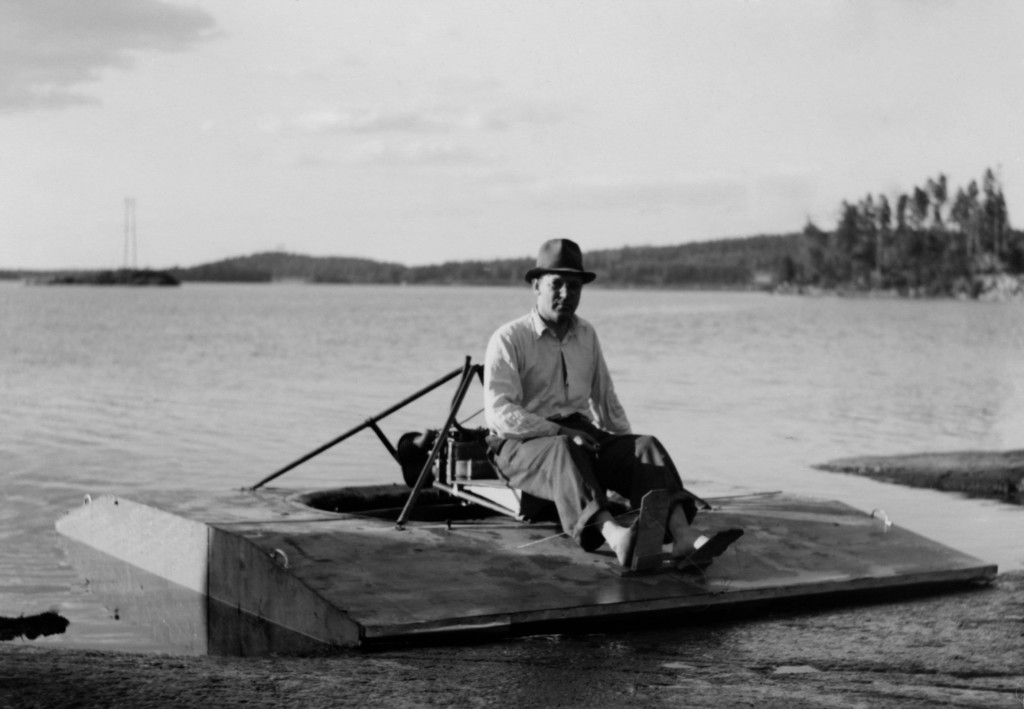
Toivo Kaario on an early Pintaliitäjäprototyypin in mid-1935
Based on experience testing the first prototype, Kaario went on to build a second prototype, Patosiipi No. 2 which he tested over 1935-1936. Kaario began to develop his theories concerning the use of ground-effect and built several models for further tests. As the ground-effect wing of Kaario’s early designs had an almost non-existent ability to block the loss of air being blown down by the propeller, the Patosiipi No. 2 was able to lift, but the ground-effect lift was weak. Kaario continued to experiment through 1936, building a further full-sized prototype powered by a 2-cylinder Harley-Davidson motorcycle engine but this time with a ”skirt” underneath which added to the lift by trapping the high pressure air that had been forced. This device was first tested on land and then on the water and was found to be slower but with more lift over an uneven surface. It was at this point that Kaario had discontinued his research and trials as he had graduated and is spare time in Berlin was largely taken up with his studies. However, he did have some free time….
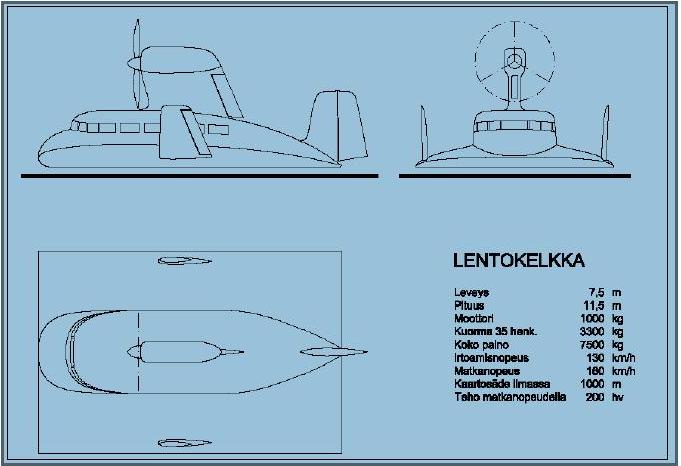
Line Drawing of Pintaliitäjä-Craft proposed by Kaario in Spring 1939
And Kaario used this time well, bouncing his ideas around with German aviation experts, draw new designs, build and test models and come up with further improvements. In the late 1930’s when Kaario was in Germany, German aviation had been released from the shackles imposed after the defeat of WW1, the Luftwaffe was expanding rapidly, German aviation designers were trying out a variety of new ideas and concepts, some of them out there on the bleeding edge of technology, many of them merely leading edge, and Kaario found himself in the thick of this. His interests led him to make many contacts, and on his return to Finland in January 1939, Kaario had accumulated two years worth of ideas, thoughts and interaction with German aviation experts as well as having constructed and trialed a large number of models. Almost all his spare time was taken up with building and testing models and almost immediately he also began work on Patosiipi No. 8 which had substantially improved lift and air flow properties. At this stage a number of fellow workers at the State Aircraft Factory had become interested in his project and provided voluntary assistance. Work on Patosiipi No. 8 progressed rapidly utilizing a 53hp Porsche engine and before the snow was off the ground in the Spring of 1939, the device was first tested on land beside the Härmälä airport and then on the water at Siuro. The main problems experienced were vibration when driving on uneven ground and the inability of the prototype to drive over obstacles more than 20-cm-high. Sometimes serendipity plays its part in events. It was the testing beside Härmälä airport that inadvertently led to far more rapid progress than Kaario had anticipated. Major-General Somersalo had been attending a meeting at the Airport which had run late. On leaving, he happened to see the group working on Patosiipi No. 8 and stopped to watch as a test run was carried out, with the device reaching some 80 kph while carrying two people. Intrigued, Somersalo had walked over to the group and started asking questions. At midnight, the entire group and Somersalo were still at the Airport with Kaario running an impromptu design review.
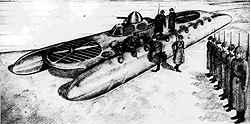
Rough Sketch of Infantry Assault Pintaliitäjä-Craft as proposed by Kaario in Spring 1939
Two days later, Kaario and his team of volunteers found themselves doing a presentation to Somersalo, the head of the Merivoimat, Väinö Valve, the commanding officer of the Marine Jaegers, a small group of technical Officers and a couple of rather tough looking individuals in nondescript Maavoimat uniforms without any rank or branch identification. Kaario seized the opportunity and over a single day, he outlined the concepts and ideas he had put together while in Germany, starting with plans for a 100 ton Pintaliitäjä intended for transport on the Baltic Sea and with a cruising speed of 100-120 kph, then moving on to concepts for a Fast Torpedo and Mine-layer Pintaliitäjä and a High Speed Infantry Assault Pintaliitäjä. The ”ground effect” concept was explained in detail, and then demonstrated using Patosiipi No. 8, and Kaario’s ideas on how this could better be utilized were also explained (Kaario was perhaps the first to conceive of using a ”skirt” to trap air, rather than simply using ground-effect).
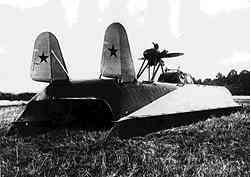
P-9 during initial trials in Spring 1939- the Red Star and ”CCCP” were painted on the sides to confuse any Observers, as it was known that the USSR was conducting trials on a similar type of craft designed by a Soviet engineer, Vladimir Levkov. It was hoped that any sightings of the Finnish craft would be confused with the Soviet Navy craft that had been observed carrying out trials.
The next morning he was summoned to the office of the Manager to find, not the Manager but the Commanding Officer of the Merivoimat, Väinö Valve. After a short and to the point discussion, Valve asked Kaario if he would take on a position as leader of a design and development team tasked with turning his Pintaliitäjä concept into a viable military weapon within a 12 month period. Adequate resourcing would be provided and the project would have the full backing of the Merivoimat. Kaario agreed. Almost immediately, a team was assembled and design work began for a full-size prototype of the Fast Torpedo and Mine-layer Pintaliitäjä. The first prototype, maintaining the numbering sequence Kaario had initiated in 1932 was designated P-9, and had a very simple design which consisted of an elongated oblong shape made up two wooden catamaran hulls and powered by three aircraft engines using what we would now call a chamber configuration design. Two Mercury aero-engines were installed horizontally in the funnel-shaped wells on the platform which connected the catamaran hulls together. The third engine, also a Mercury, was placed in the aft part of the craft on a removable four-strut pylon. An air cushion was produced by the horizontally-placed engines. P-9 was designed and built over a one week period and was immediately trialed, achieving a speed of 70 knots, or about 130 kilometers per hour.

Initial design sketch of P-10
The tests lasted for 10 days and at that time nobody other than Kaario and his small team of volunteers had any experience in operating such vehicles. Over-water runs were performed using all three engines running simultaneously, with the trials conducted in both calm and windy weather, crosswind and downwind, over flat shore and over swampy areas covered with sedge. Once the hovercraft’s engines failed and the vehicle landed in a deep swamp. However, as soon as the engines were restarted, the boat ascended and recovered itself from the swamp. The maximum speed in the first runs was approximately 60 knots but in later tests 70 knots was easily reached and according to the P-9 test commander, a Merivoimat Fast Torpedo Boat commander, this was not on full power. Trial results of this first prototype hovercraft were acknowledged as very satisfactory. It was indicated in the report that the “principle for surface-soarer vehicles has been proven feasible.” This report was approved by the Commander of the Merivoimat, who directed that the Naval Construction Plan should encompass the production of two types of such skimming boats: one to be used as a fast attack torpedo craft and the other as a marine landing craft. Emergency Funds were allocated and the project was given the highest priority with a direction that three prototypes of each were to be constructed and completed by the end of summer 1939. This was a highly aggressive timetable, but one that the team worked day and night to meet.

P-10 at rest during a break in her initial trials P-10 had been designed over a four week period and a prototype was put together by mid-July 1939.
Building on knowledge gained from the P-10, a full-metal (duralumin) fast torpedo and infantry assault craft, designated P-11 was built in late summer 1939. The craft had a streamlined shape, in the midships area there was a streamlined pilot house/cabin for the pilot, mechanic and radio operator followed by a troop compartment, two turret (aircraft turrets were used, as had been done with some of the patrol torpedo boats) machine-gun mounts were installed on either side and slightly aft of the pilot-house and there was an aft mounted rear-facing 20mm cannon for AA protection. Directional control was provided by two large tail fins. Torpedo attachment points were arranged on either side of the troop compartment and the craft could also carry eight depth charges. The P-11 could surmount sandy strips, bogs, ice and rough seas, but was unstable during high speed turns. Regardless, a decision was made that it should go into production and by November 1939, the Merivoimat had 21 experimental air-cushion dual-purpose P-11 Pintaliitäjä-boats (High-Speed Torpedo Boats and Assault Craft) in service. The P-11 had a tonnage of 8.6-11.3 t, a crew of 7 men, a length of 24m, a width of 5.4 m, was armed with 2 x 12.7mm machine guns and 1 x 20mm Hispano-Suiza 20 mm Cannon, carried two torpedoes, was powered by 2 x 1000 hp Hispano-Suiza engines and could reach a top speed of 80 knots (approx 160 kph).
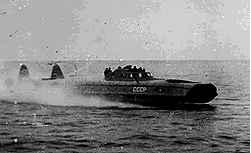
Performance Trials of P-10 on the Gulf of Finland, Summer of 1939. ”CCCP” was painted on the sides to confuse any Observers, as it was known that the USSR was conducting trials on a similar type of craft designed by a Soviet engineer, Vladimir Levkov. It was hoped that any sightings of the Finnish craft would be confused with the Soviet Navy craft that had been observed carrying out trials.
As the Winter War broke out, Kaario’s team worked on manufacturing additional P-11 Pintaliitäjä-boats and repairing these that had been damaged while Kaario next began to work on an improved P-11 design as well. Then, as this changed radically, it became the design for a larger and longer-ranged P-12 Pintaliitäjä-boat. With more P-11’s having been built and actually being used in operations during the early weeks of the Winter War, Kaario realized the craft had some serious shortcomings. Both good and discouraging reports were coming from the Merivoimat. The discouraging reports stated that pressure under the Pintaliitäjä-boats was low due to air escape through the vessels open ends, which reduced the load-carrying capacity; spray produced by the powerful engines limited visibility, the Pintaliitäjä-boats operations were limited to sea state 4 or less and the impact of the Pintaliitäjä-boats with waves changed the settings of the louvres and occasionally damaged them. The engines also had problems with stalling when water penetrated into the exposed carburetors, and since the engines were positioned horizontally, they were not sufficiently air-cooled and would often overheat if run for long periods of time. Despite this, the Pintaliitäjä-boats had proved highly effective in combat due largely to their unbelievably high speeds.
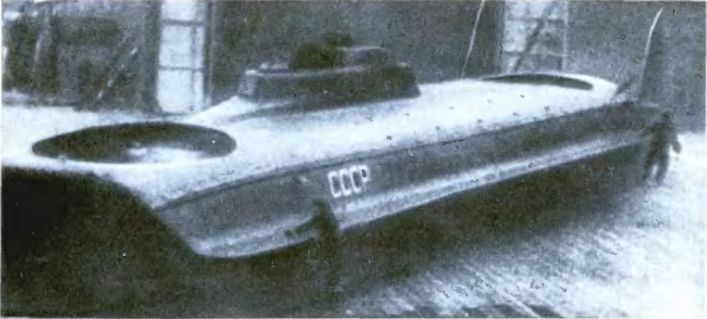
P-10 in the Suomenlinna Workshop
Kaario and his design team worked 16 hour days working to rectify these problems, often sleeping under their desks in the ex-VL Suomenlinna factory building that was now their base. In the end, the ability of the P-11 design to cope with high speed turns seemed to improve with a substantial widening of the boat, first to 10 m and then to 15 m. As for lift, Kaario initially experimented with the building of a working model that demonstrated that by pumping air into a narrow tunnel around the perimeter of the underneath of the craft, it would flow towards the center, creating a more effective air cushion. This peripheral jet would allow the air pressure to build enough to equal the weight of the craft and, since the air would be trapped, the pressure would elevate the craft off the surface upon which it traveled. By contrast, the P-11 utilized ground-effect, basically provided lift by using a propeller fan to force air from the deck down into the chamber between the two catamaran sides, which meant that air had to be continually pumped down to replace the air that escaped. After successfully trialing a model demonstrating that his new “air cushion” theory worked, Kaario redesigned P-12 incorporating a number of other modifications, a subject we shall return to after the Winter War.
In the Winter War itself, the Pintaliitäjä-boats saw limited use in the early weeks of the war as the Soviet Navy was quickly restricted to the naval base of Kronstadt. However, as the Gulf of Finland and Lake Laatokka froze over in the coldest winter experienced in many years, the Pintaliitäjä-boats proved capable of being effectively used in the ice. With torpedoes removed and heavily armed with machine-guns and cannon, they proved useful in countering Red Army attempts to attack across the ice. Used in conjunction with the Finnish Army`s aerosleds, the Pintaliitäjä-boats also gave the Finnish Army the ability to move small but heavily armed forces of infantry with extreme rapidity where required.
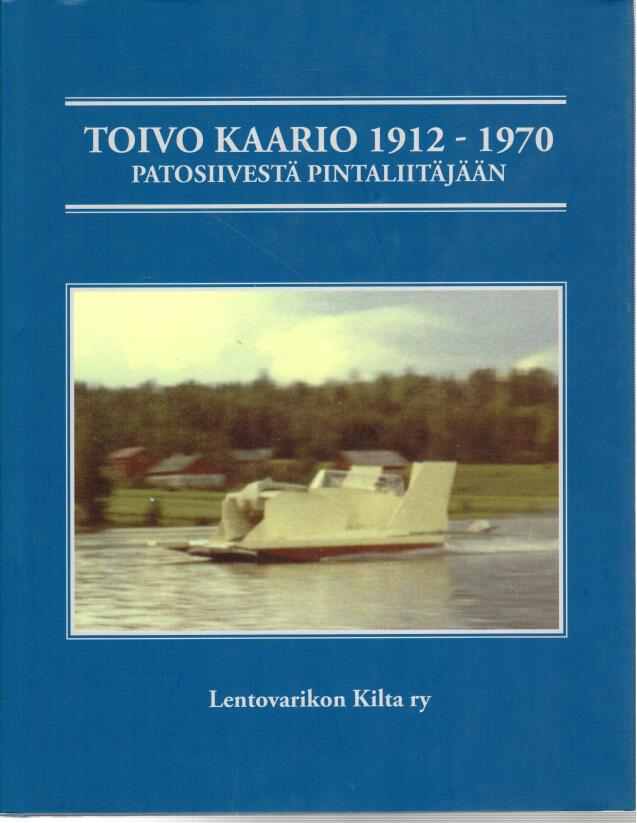
160 page book on Toivo Kaario published in 2007, Publisher: Lentovarikon Kilta ry and in Finnish
OTL Note: Historically, Toivo Juhani Kaario was a Finnish engineer and inventor, who in the 1930s started working on prototypes of air cushion vehicles. Kaario is considered to have designed and built the first functional ground effect vehicles, but his invention did not receive sufficient funds for further development. Also, in this ATL I have shifted the dates by a couple of years to fit the scenario. But all else aside, Kaario WAS the first in the world to design and build functional ground effect vehicles and the Soviet engineer, Vladimir Levkov, followed his efforts as closely as was possible before building his own pre-WW2 combat hovercraft for the USSR (on which my P-series hovercraft are modeled)……
In real life, Kaario served as an infantry team leader in the Winter War and fought on the Karelian Isthmus at Summ and elsewhere. Before the war he had sat entrance exams for pilot training with the Air Force but failed due to his vision. After the war, Kaario was promoted to lieutenant in July 1940. In the autumn of 1940 he resumed his studies at the Helsinki University of Technology and completed his studies in December 1940. Kaario was transferred to the State Aircraft Factorywhere he worked as an engineer, first at Tampere and in 1941 in Kokkola. Kaario led experiments designed to investigate various types of gasoline-alcohol mixtures for use as aero-engine fuel. Such domestic use could reduce the need to import gasoline. Kaario spent the rest of WW2 as a Design Engineer with the State Aircraft Factory. From 1942-44 he studied aero-engine design at the Charlottenburg Technical University in Berlin.
After WW2, he resumed working on his surface-soarer designs and prototypes and in 1959, Valmet Corp. became interested and financed the construction of a prototype, which was built over 1959-1960. Also in 1949, Kaario presented a paper to the International Symposium on Ground Effect Phenomena at Princeton University, which resulted in many international contacts and interest by the US military. Following an accident in which one person died (a collision between the prototype and a motor boat), development ended but Kaario continued in the 1960s writing articles and developing ideas. He designed in 1966, an air-cushioned train that would have moved in a trough-shaped track. Kaario also followed foreign hovercraft development work. In 1970 he was elected first honorary member of the International Air Cushion Engineering Society .
Toivo Kaario died at the age of 58 after a short illness in October 1970. He is buried at Tampere in the Kalevankangas Cemetery.
Here`s a link to a lengthy article on Toivo Kaario (in Finnish) by Pertti Korhonen
And here`s a videoclip of the Finnish Navy`s Tuuli hovercraft. Tuuli was built at the Aker Finnyards Rauma shipyard in Rauma, Finland in 2002. She was intended to be the lead vessel of a class of four combat hovercraft that would form part of Squadron 2000, a vessel procurement program of the Finnish Navy. Before naming, the hovercraft were referred to as the T-2000 class. The hovercraft were intended to be used as mobile missile platforms that would be able to navigate and perform surprise attacks in the fractured Finnish archipelago. It was an attack vessel, not a landing craft or transport. Since the seas around Finland usually freeze over in the winter, parts of the archipelago cannot be navigated by conventional surface combatants and are accessible only by air or with a hovercraft.Her trial runs proved a success and her specified capacity and maximum speed were exceeded. On 19 December 2003, it was announced that the Tuuli class would not enter active service and the prototype vessel would be presented for sale. There was foreign interest towards purchasing Tuuli, but no further details have been given. The vessel was stored at the Upinniemi base. On 10 July 2013, it was announced that Tuuli would be scrapped as no suitable buyer has been found. She was broken up in October 2013.
Ahhhh, what might have been….
Table of Contents
Previous Page:
Next Page;
 Copyright secured by Digiprove © 2015 Alternative Finland
Copyright secured by Digiprove © 2015 Alternative Finland

